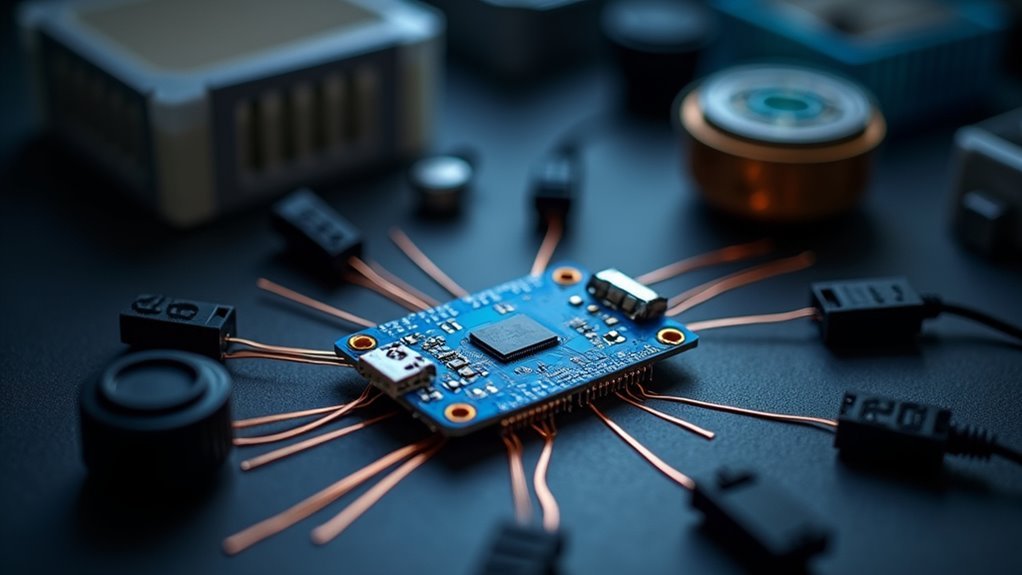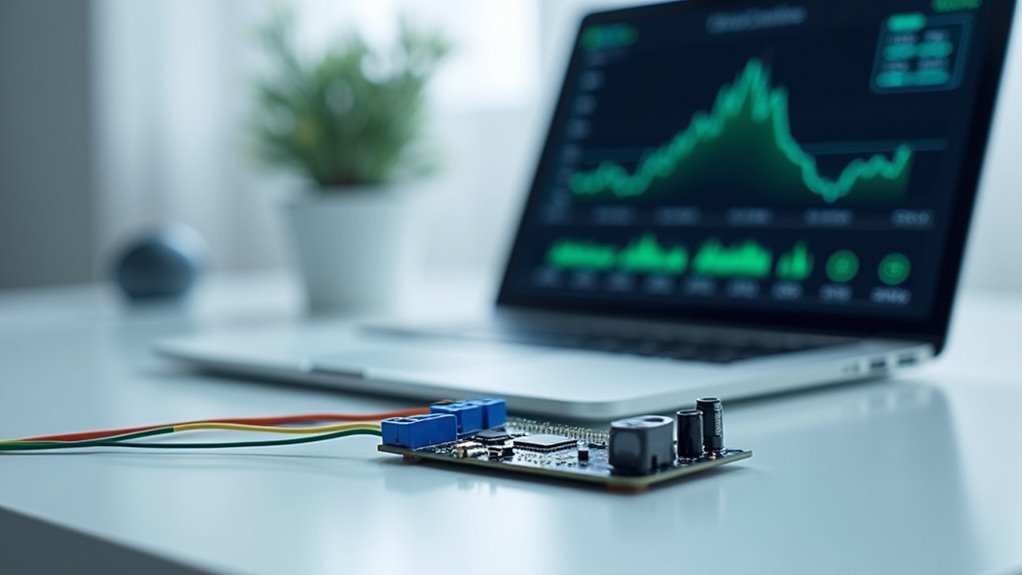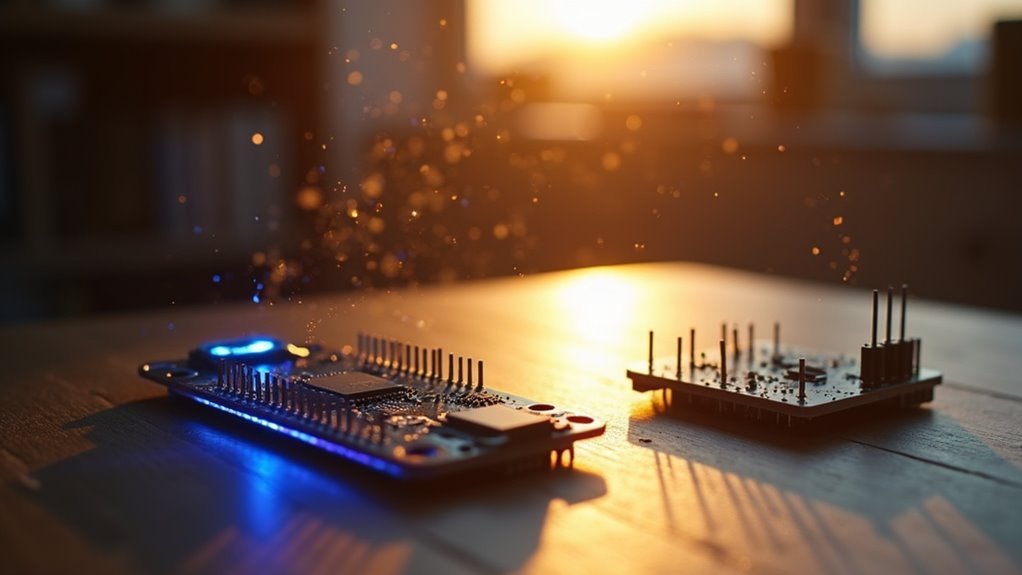You’re breathing air that could be silently affecting your health, but you probably don’t know its actual quality. The ESP8266 microcontroller changes this by transforming air quality monitoring from an expensive, complex process into an affordable DIY project. With its built-in Wi-Fi and sensor compatibility, you can create a real-time monitoring system that tracks pollutants, humidity, and harmful gases in your home or office. What you discover might surprise you.
The Power of the ESP8266 Microcontroller

The ESP8266 microcontroller transforms air quality monitoring from a complex engineering challenge into an accessible DIY project.
You’ll find this low-cost, compact device delivers integrated Wi-Fi capabilities that make it perfect for IoT-focused air quality applications. The ESP8266 microcontroller’s programming simplicity through Arduino IDE means you can develop real-time data collection and transmission applications with minimal effort.
You can connect various sensors like DHT11 and MQ135 to monitor temperature, humidity, and air quality parameters thoroughly.
The built-in Wi-Fi functionality enables remote access to your sensor data, allowing seamless integration with visualization platforms like Thingspeak.
You’ll appreciate its ability to handle multiple connections and protocols, including HTTP and MQTT, providing flexible data transmission options and smooth integration with other IoT devices.
Essential Sensors for Air Quality Detection
You’ll need specific sensors to detect harmful gases and monitor environmental conditions that affect air quality.
The MQ135 gas sensor captures ammonia, CO2, and methane levels, while sensors like the DHT11 and BME280 track temperature, humidity, and atmospheric pressure.
For complete air quality assessment, you’ll also want a PMS5003 sensor to measure dangerous particulate matter including PM1.0, PM2.5, and PM10 concentrations.
Gas Detection Capabilities
When building an effective air quality monitoring system with ESP8266, selecting the right gas sensors determines your project’s detection capabilities and accuracy.
You’ll find the MQ-135 gas sensor essential for detecting harmful gases like ammonia, benzene, and carbon dioxide, providing thorough air quality assessments. Each MQ gas sensor operates by measuring resistance changes when exposed to specific gases, delivering precise pollutant detection in parts per million.
The MQ-2 specializes in smoke and flammable gas detection, offering vital fire safety monitoring data.
For methane detection in residential and industrial environments, you’ll want the MQ-4 sensor to identify potential gas leaks.
Integrating multiple sensors, such as combining MQ-9 and MQ-135 units, enhances your monitoring system’s ability to deliver complete indoor and outdoor air quality analysis.
Environmental Parameter Monitoring
Beyond gas detection, thorough air quality monitoring requires sensors that track fundamental environmental parameters affecting both air composition and human comfort.
Your Air Quality Monitoring System needs the DHT11 sensor to measure temperature and humidity, providing essential data for evaluating overall environmental conditions.
The BME280 sensor offers superior accuracy by measuring temperature, pressure, and humidity simultaneously, giving you all-encompassing environmental readings.
You’ll also need the PMS5003 sensor to detect particulate matter concentrations, including PM1.0, PM2.5, and PM10—critical indicators of air quality and health risks.
These particles directly impact respiratory health and air pollution levels. Together with gas sensors like the MQ-135, these environmental monitoring components create a complete picture of your indoor or outdoor air quality conditions.
Real-Time Data Collection and Transmission

Since monitoring air quality requires immediate access to environmental data, the ESP8266’s real-time collection and transmission capabilities become essential for effective environmental surveillance.
You’ll benefit from the microcontroller’s ability to gather data from sensors like DHT11 for temperature and humidity, plus MQ135 for air quality measurements. The ESP8266’s built-in Wi-Fi functionality lets you transmit this information directly to cloud platforms such as Thingspeak without additional hardware.
You can configure your system to send sensor data in JSON format at predetermined intervals, ensuring continuous monitoring.
This real-time data collection enables immediate visualization through web interfaces, allowing you to track environmental changes as they occur. With instant access to current air quality conditions, you’ll make informed health decisions and receive timely alerts when air quality deteriorates.
Wi-Fi Connectivity Enables Remote Monitoring
The ESP8266’s integrated Wi-Fi capabilities transform your air quality monitoring system into a powerful remote surveillance tool.
You’ll access real-time sensor data from anywhere using your smartphone or computer, eliminating the need for physical device proximity. Wi-Fi connectivity enables seamless data transmission to remote servers and cloud platforms like Thingspeak, where you can visualize trends and analyze air quality patterns over time.
Your system gains flexibility through REST API implementation, allowing programmatic data retrieval via HTTP requests.
You can connect to multiple Wi-Fi networks, ensuring continuous monitoring even when network conditions change. This connectivity transforms basic sensor readings into an extensive monitoring solution that keeps you informed about air quality conditions whether you’re at home, work, or traveling.
Cost-Effective Solution for Home Air Quality

While commercial air quality monitors can cost hundreds of dollars, you’ll build a thorough monitoring system with an ESP8266 for under $20. This cost-effective solution for home air quality combines an affordable ESP8266 microcontroller (under $5) with inexpensive sensors like the DHT11 and MQ135.
You’ll monitor temperature, humidity, and air quality without breaking the bank.
The ESP8266’s built-in Wi-Fi eliminates expensive data logging equipment by transmitting real-time data directly to cloud platforms like Thingspeak. You’re getting continuous air quality monitoring that alerts you to poor conditions, potentially reducing health-related expenses over time.
The system’s versatility means you can easily scale and customize your setup. You’ll expand your home monitoring capabilities without significant additional costs, making this an intelligent investment in your family’s health.
Integration With Thingspeak Iot Platform
Once you’ve assembled your ESP8266 air quality monitor, connecting it to Thingspeak transforms your device into a powerful IoT analytics system. You’ll create an account, generate your API key, and embed it in your ESP8266 code for authenticated data uploads. Your sensor automatically sends readings through HTTP POST requests at defined intervals, updating air quality metrics continuously.
| Feature | Benefit |
|---|---|
| Real-time dashboards | Visualize sensor trends instantly |
| Custom alerts | Receive notifications at thresholds |
| Data analytics | Track long-term air quality patterns |
| Multiple parameters | Monitor temperature, humidity, gases |
| Free platform | No subscription costs required |
Thingspeak’s customizable dashboards let you monitor trends and make informed decisions based on your sensor’s real-time analysis. You can also configure alert triggers for specific air quality thresholds.
LCD Display for Local Data Visualization
You’ll want to add an LCD display to your ESP8266 air quality monitor for immediate access to sensor readings without relying on internet connectivity.
The I2C interface makes setup straightforward with just four connections, and you can configure the display to show real-time temperature, humidity, and pollution data on rotating screens.
You can even implement a backlight alert system that changes the display’s appearance based on air quality thresholds, giving you instant visual feedback about your environment’s safety.
Real-Time Data Display
As you integrate sensors into your ESP8266 air quality monitor, displaying real-time data locally becomes essential for immediate environmental awareness. Your LCD display transforms raw sensor readings into actionable information without requiring external platforms or internet connectivity.
The real-time data display setup involves these key components:
- 16×2 LCD with I2C interface – Connects using just four wires for simplified wiring
- LiquidCrystal_I2C library initialization – Enables seamless communication at address 0x27
- Continuous data updates – Refreshes environmental readings every few seconds automatically
- Customizable display output – Shows specific metrics like PM2.5 levels or VOC concentrations
You’ll appreciate having immediate access to temperature, humidity, and gas concentration data.
This local visualization approach guarantees you can monitor indoor air quality instantly, making informed decisions about ventilation or air purification needs.
I2C Configuration Setup
Setting up I2C communication for your LCD display requires precise wiring and proper library configuration to guarantee seamless data visualization.
You’ll connect your 16×2 LCD display to the ESP8266’s SDA and SCL pins, specifically D2 and D1 on the NodeMCU. The I2C address typically defaults to 0x27, but you must verify this for your specific device to avoid communication failures.
Install the LiquidCrystal_I2C library and initialize it with 16 columns and 2 rows parameters.
Double-check your wiring connections between the LCD’s SDA/SCL pins and your ESP8266’s corresponding GPIO pins. Once configured correctly, your LCD will continuously update with real-time temperature, humidity, and air quality readings, providing immediate local access to your environmental monitoring data without requiring external devices.
Backlight Alert System
When air quality readings exceed safe thresholds, your LCD’s backlight alert system transforms from a simple display into an active warning device. This intelligent feature guarantees you’ll never miss critical environmental changes that could impact your health.
The flashing backlight creates immediate visual feedback when your ESP8266 detects dangerous conditions. You can monitor the air quality continuously while the system actively alerts you to:
- PM2.5 particles exceeding WHO recommended levels
- CO2 concentrations reaching unsafe indoor thresholds
- Temperature spikes indicating ventilation problems
- Humidity levels promoting mold growth
Your 16×2 LCD display refreshes at programmed intervals, providing real-time updates that enable quick responses to deteriorating conditions.
This proactive approach helps you maintain healthier indoor environments.
Web Server API for Data Access
The ESP8266’s built-in web server creates a powerful API that lets you access your air quality data remotely through simple HTTP requests.
You’ll retrieve real-time temperature and humidity readings, plus gas concentration values from your MQ-135 sensor in JSON format. The Internet of Things (IoT) capabilities allow you to monitor Air Pollution levels by sending GET requests to specific endpoints like `/temperature`, `/humidity`, `/ppm`, and `/rzero` using your device’s IP address.
You don’t need specialized software since any web browser works perfectly. The low power consumption makes continuous monitoring practical, while integration with platforms like Thingspeak enables thorough data visualization.
You’ll need to configure your Wi-Fi credentials and API key in the Arduino IDE to guarantee seamless data transmission for effective Air Quality monitoring.
Hardware Requirements and Circuit Connections
You’ll need specific hardware components to build your ESP8266-based air quality monitoring system effectively.
The wiring configuration between your microcontroller and sensors determines whether your project functions correctly or fails completely.
Understanding each sensor’s connection requirements guarantees you’ll achieve accurate readings and reliable data transmission to your web server.
Essential Components Overview
Building a reliable air quality monitoring system starts with selecting the right hardware components and establishing proper connections. You’ll need the NodeMCU ESP8266 microcontroller as your main board, providing built-in Wi-Fi capabilities for seamless data transmission.
Your essential sensor lineup includes:
- DHT11 sensor – measures temperature and humidity levels in your environment
- MQ135 gas sensor – detects harmful gases and connects directly to the A0 pin
- PMS5003 particulate sensor – analyzes dust and particle concentrations using UART communication
- BME280 sensor – provides precise environmental readings through I2C protocol
You’ll also need a 4.7k Ohm resistor for circuit stability, particularly for I2C connections.
Remember to disconnect the PMS5003’s Rx and Tx pins during code upload to prevent errors.
Wiring Configuration Guidelines
Proper sensor wiring forms the backbone of your air quality monitoring system’s reliability and accuracy.
You’ll connect the PMS5003 sensor to your NodeMCU ESP8266 through UART communication, linking VCC, GND, Rx, and Tx pins for seamless data transmission.
Wire the MQ-135 gas sensor to the A0 pin while ensuring VCC and GND connections are secure.
For the BME280 sensor, you’ll use I2C communication by connecting its SCL and SDA pins to the NodeMCU’s D1 and D2 pins respectively, enabling temperature, pressure, and humidity measurements.
Remember to disconnect the PMS5003’s Rx and Tx pins during code uploads to prevent interference with the programming process.
Double-check all connections before powering up your system.
Sensor Connection Requirements
Before assembling your air quality monitoring circuit, make certain you have the essential hardware components: a NodeMCU ESP8266 development board, PMS5003 particulate matter sensor, MQ-135 gas sensor, and BME280 environmental sensor.
Your sensor connections require specific protocols and pins for peak performance:
- PMS5003 dust sensor – Connect via UART using VCC, GND, Rx, and Tx pins for precise PM measurements.
- MQ-135 gas sensor – Wire directly to the A0 analog pin for PPM air quality readings.
- BME280 environmental sensor – Utilize I2C protocol by connecting SCL and SDA pins to D1 and D2 respectively.
- NodeMCU ESP8266 – Serves as your central hub with built-in Wi-Fi for seamless data transmission.
Remember to disconnect the PMS5003’s Rx and Tx pins during code uploads to prevent communication conflicts.
Software Development and Arduino Programming
Once you’ve assembled your ESP8266-based air quality monitoring hardware, you’ll need to develop the software that brings your sensors to life through Arduino programming. You’ll write code in C++ using the Arduino IDE, which seamlessly integrates with sensors like DHT11, MQ135, and BME280.
| Component | Library Required | Function |
|---|---|---|
| LCD Display | LiquidCrystal_I2C | Real-time data visualization |
| Wi-Fi Connection | ESP8266WiFi | Network connectivity |
| Cloud Upload | HTTPClient | Data transmission to Thingspeak |
| Gas Sensor | MQ135 | Air quality measurement |
| Temperature/Humidity | DHT | Environmental monitoring |
Your code structure should include functions for Wi-Fi establishment, sensor initialization, data collection, and cloud transmission. Remember to calibrate your MQ135’s RZero value for accurate readings, ensuring reliable air quality measurements displayed locally and remotely.
Sensor Calibration and Accuracy Optimization
While your ESP8266 air quality monitor’s hardware and software foundation is complete, achieving accurate measurements requires meticulous sensor calibration that transforms raw readings into reliable environmental data.
Your MQ135 gas sensor needs an essential 24-hour power-up period before it’ll deliver accurate PPM readings. Each sensor carries unique RZero values that you must calibrate and embed in your code for best performance.
Follow these calibration steps:
- Expose sensors outdoors at 20°C with 35% humidity for baseline readings
- Set unique RZero values for MQ135, PMS5003, and BME280 sensors in your code
- Monitor temperature and humidity effects on DHT11 accuracy during operation
- Compare readings regularly against expected ranges to identify inconsistencies
Environmental factors greatly impact sensor accuracy, so you’ll need to maintain best operating conditions throughout your monitoring process.
Health Benefits of Indoor Air Quality Monitoring
You’ll gain powerful early warning capabilities when your ESP8266 system detects elevated CO2 levels above 1000 ppm or harmful PM2.5 concentrations before they trigger serious health problems.
Your respiratory system benefits directly from continuous monitoring that alerts you to air quality changes, helping prevent asthma attacks, allergies, and other breathing difficulties before symptoms appear.
You’ll also notice improved sleep quality as your monitoring system maintains ideal humidity levels between 30-60% and guarantees clean air throughout the night.
Early Health Risk Detection
Since harmful pollutants often accumulate indoors without obvious warning signs, an ESP8266-powered air quality monitoring system serves as your first line of defense against invisible health threats.
Your monitoring setup detects dangerous conditions before they impact your wellbeing, giving you vital time to respond.
Here’s what early detection prevents:
- CO2 poisoning – Alert triggers when levels exceed 1000ppm, preventing drowsiness and cognitive impairment
- Particle overload – PM2.5 warnings at 25µg/m³ help avoid respiratory irritation and lung damage
- Mold development – Humidity alerts above 60% stop fungal growth that causes breathing problems
- VOC exposure – MQ135 sensor catches toxic vapors before they trigger headaches and dizziness
You’ll receive instant notifications, empowering immediate action to protect your health.
Respiratory Disease Prevention
Three critical respiratory conditions—asthma, COPD, and chronic bronchitis—worsen dramatically when your ESP8266 air quality monitor detects elevated PM2.5 particles above safe thresholds.
You’re protecting yourself from indoor pollutants that can reach five times higher concentrations than outdoor air, according to WHO data.
Your ESP8266 system tracks humidity levels between 30-50%, reducing airborne virus survival and allergen presence that trigger respiratory infections.
Real-time monitoring enables immediate interventions when harmful gas concentrations spike or temperature fluctuations create breeding grounds for pathogens.
You’ll receive instant alerts when conditions deteriorate, allowing prompt action like activating air purifiers or adjusting ventilation.
This proactive approach prevents respiratory disease progression by maintaining ideal indoor environments that support healthy breathing patterns and reduce inflammation triggers.
Sleep Quality Improvement
Beyond preventing respiratory diseases during waking hours, your ESP8266 air quality monitor becomes a powerful tool for enhancing sleep quality throughout the night.
Poor indoor air greatly disrupts your sleep patterns, with high CO2 levels above 1000 ppm reducing sleep efficiency and duration.
Your monitoring system helps you maintain ideal conditions by tracking:
- VOCs and particulate matter that trigger sleep disturbances and respiratory irritation
- Humidity levels between 30-60% preventing dry airways and uncomfortable sleeping conditions
- CO2 concentrations ensuring adequate oxygen for deep, restorative sleep cycles
- Real-time pollutant alerts prompting immediate ventilation or air purification actions
You’ll receive instant notifications when air quality deteriorates, allowing timely interventions.
This proactive approach reduces allergens and irritants, creating the best sleeping environment your body needs for quality rest.
Expandable System for Multiple Environmental Parameters
While basic air quality monitoring provides valuable insights, the ESP8266’s true strength lies in its ability to create an extensive environmental monitoring ecosystem. You can seamlessly integrate multiple sensors to track thorough environmental data beyond simple air quality measurements.
| Sensor Type | Parameters Monitored |
|---|---|
| DHT11 | Temperature & Humidity |
| MQ135 | Gas Detection |
| BME280 | Pressure Monitoring |
| PM2.5/VOC | Particulate & Chemical Detection |
The modular design allows you to add new sensors as your monitoring needs evolve. You’ll customize data visualization and alerts based on multiple environmental parameters, tailoring the system to your specific health requirements. The ESP8266 can automatically trigger devices like exhaust fans when pollutant thresholds are exceeded, creating an adaptive response system that maintains ideal air quality conditions.
Battery Operation and Portable Monitoring Capabilities
Although stationary monitoring provides thorough data, you’ll often need air quality measurements in locations where power outlets aren’t available. The ESP8266’s low power consumption enables extended battery life, making it perfect for portable air quality monitoring.
You can deploy your system in remote areas, parks, or construction sites without worrying about electrical infrastructure.
Battery-powered operation offers you:
- Remote wilderness monitoring – Track air quality in forests, mountains, or beaches where no electricity exists
- Mobile personal monitoring – Carry the device while hiking, cycling, or traveling to new locations
- Temporary event monitoring – Set up quick measurements at outdoor festivals, markets, or construction zones
- Emergency deployment – Rapidly assess air quality during disasters or environmental incidents
Rechargeable batteries guarantee sustainable operation while Wi-Fi transmission delivers real-time data remotely.
Frequently Asked Questions
What Is the Use of Air Quality Monitor?
You’ll track harmful pollutants, gases, and particulate matter to protect your health. It helps you identify respiratory risks, make informed decisions about ventilation, and maintain safe indoor environments for you and your family.
Why Is Air Quality Monitored?
You’ll protect your health by monitoring air quality since pollutants cause respiratory diseases and premature deaths. You can make informed decisions about outdoor activities and guarantee you’re complying with environmental regulations.
Do You Need an Air Quality Monitor?
You need an air quality monitor if you’re concerned about indoor pollutants affecting your health. It’s especially important if you have respiratory issues, allergies, or live in polluted areas.
How to Monitor Air Pollution in Iot?
You’ll connect air quality sensors like MQ-135 and PMS5003 to ESP8266 microcontrollers, then transmit data wirelessly to cloud platforms like ThingSpeak for real-time monitoring and analysis of pollution levels.





Leave a Reply